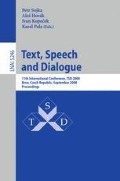Abstract
Writer-based and reader-based views of text-meaning are reflected by the respective questions “What is the author trying to tell me?” and “What does this text mean to me personally?” Contemporary computational linguistics, however, generally takes neither view. But this is not adequate for the development of sophisticated applications such as intelligence gathering and question answering. I discuss different views of text-meaning from the perspective of the needs of computational text analysis and the collaborative repair of misunderstanding.
Access this chapter
Tax calculation will be finalised at checkout
Purchases are for personal use only
Preview
Unable to display preview. Download preview PDF.
References
Allan, J.: HARD track overview in TREC 2005. In: The 14th Text REtrieval Conference (TREC 2005) Proceedings, NIST (2006)
Barwise, J., Perry, J.: Situations and Attitudes. MIT Press, Cambridge (1983)
Carberry, S.: Plan Recognition in Natural Language Dialogue. MIT Press, Cambridge (1990)
Corriveau, J.-P.: Time-constrained Memory: A reader-based approach to text comprehension. Lawrence Erlbaum Associates, Mahwah (1995)
Farwell, D., et al.: Interlingual annotation of multilingual text corpora and FrameNet. In: Boas, H. (ed.) Multilingual FrameNets in Computational Lexicography, Mouton de Gruyter (to appear)
Fish, S.: Is there a text in this class? The authority of interpretive communities. Harvard University Press (1980)
Forbus, K.D., et al.: Integrating natural language, knowledge representation and reasoning, and analogical processing to learn by reading. In: Proceedings, 22nd AAAI Conference on Artificial Intelligence (AAAI-2007), Vancouver, pp. 1542–1547 (2007)
Grice, H.P.: Utterer’s meaning, sentence-meaning, and word-meaning. Foundations of Language 4, 225–242 (1968)
Grosz, B.J., Sidner, C.L.: Attention, intentions, and the structure of discourse. Computational Linguistics 12(3), 175–204 (1986)
Hirst, G.: Negotiation, compromise, and collaboration in interpersonal and human-computer conversations. In: Proceedings, Workshop on Meaning Negotiation, 18th National Conference on Artificial Intelligence (AAAI-2002), Edmonton, pp. 1–4 (2002)
Hirst, G.: Views of text-meaning in computational linguistics: Past, present, and future. In: Dodig-Crnkovic, G., Stuart, S. (eds.) Computation, Information, Cognition – The Nexus and the Liminal, pp. 270–279. Cambridge Scholars Publishing (2007)
Hollingsworth, B., Teufel, S.: Human annotation of lexical chains: Coverage and agreement measures. In: Workshop on Methodologies and Evaluation of Lexical Cohesion Techniques in Real-world Applications, Salvador, Brazil (2005)
Hovy, E.: Learning by reading: An experiment in text analysis. In: Sojka, P., Kopeček, I., Pala, K. (eds.) Text, Speech and Dialogue. LNCS (LNAI), vol. 4188, pp. 3–12. Springer, Heidelberg (2006)
Klebanov, B.B.: Using readers to identify lexical cohesive structures in texts. In: Proceedings, Student Research Workshop, 43\(^{\ rd}\) Annual Meeting of the Association for Computational Linguistics, Ann Arbor, pp. 55–60 (2005)
McRoy, S.: Abductive interpretation and reinterpretation of natural language utterances. Ph.D. thesis, Department of Computer Science, University of Toronto (1993)
McRoy, S., Hirst, G.: The repair of speech act misunderstandings by abductive inference. Computational Linguistics 21(4), 435–478 (1995)
Malrieu, J.P.: Evaluative Semantics. Routledge (1999)
Morris, J.: Readers perceptions of lexical cohesion in text. In: Proceedings of the 32nd annual conference of the Canadian Association for Information Science, Winnipeg (2004)
Morris, J., Hirst, G.: The subjectivity of lexical cohesion in text. In: Shanahan, J.G., Qu, Y., Wiebe, J. (eds.) Computing attitude and affect in text, pp. 41–48. Springer, Heidelberg (2005)
Nirenburg, S., Raskin, V.: Ontological Semantics. MIT Press, Cambridge (2004)
Olson, D.R.: From utterance to text: The bias of language in speech and writing. Harvard Educational Review 47(3), 257–281 (1977)
Olson, D.R.: The World on Paper. Cambridge University Press, Cambridge (1994)
Reddy, M.J.: The conduit metaphor: A case of frame conflict in our language about language. In: Ortony, A. (ed.) Metaphor and Thought, pp. 284–324. Oxford University Press, Oxford (1979)
Schank, R.C. (ed.): Conceptual Information Processing. North-Holland, Amsterdam (1975)
Schank, R.C., Abelson, R.P.: Scripts, Plans, Goals and Understanding. Lawrence Erlbaum Associates, Mahwah (1977)
Stoyanov, V., Cardie, C., Wiebe, J.: Multi-perspective question answering using the OpQA corpus. In: Proceedings, Human Language Technology Conference and Conference on Empirical Methods in Natural Language Processing (HLT/EMNLP), Vancouver, pp. 923–930 (2005)
Terasaki, A.: Pre-announcement sequences in conversation. Social Science Working Paper 99. University of California, Irvine (1976)
Ureel II, L., et al.: Question generation for learning by reading. In: Proceedings of the AAAI Workshop on Inference for Textual Question Answering, Pittsburgh, pp. 22–26 (2005)
Yoshida, S., et al.: Constructing and examining personalized cooccurrence-based thesauri on Web pages. In: Proceedings, 12th International World Wide Web Conference, Budapest (2003)
Author information
Authors and Affiliations
Editor information
Rights and permissions
Copyright information
© 2008 Springer-Verlag Berlin Heidelberg
About this paper
Cite this paper
Hirst, G. (2008). The Future of Text-Meaning in Computational Linguistics. In: Sojka, P., Horák, A., Kopeček, I., Pala, K. (eds) Text, Speech and Dialogue. TSD 2008. Lecture Notes in Computer Science(), vol 5246. Springer, Berlin, Heidelberg. https://doi.org/10.1007/978-3-540-87391-4_1
Download citation
DOI: https://doi.org/10.1007/978-3-540-87391-4_1
Publisher Name: Springer, Berlin, Heidelberg
Print ISBN: 978-3-540-87390-7
Online ISBN: 978-3-540-87391-4
eBook Packages: Computer ScienceComputer Science (R0)

